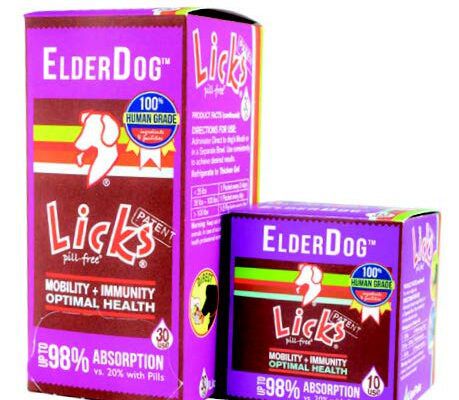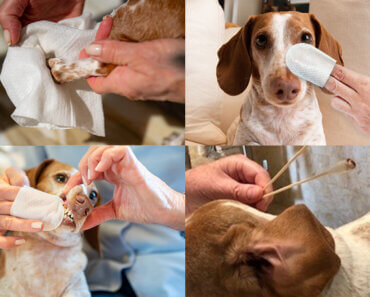Many dogs display paws-up delight when rewarded for mastering a new trick or finally heeding the sit cue with the new generation of treats that require dogs to lick rather than chew them.
Yes, 21st century dogs seem to be digging lickable treats in many forms, from homemade to commercially produced. Lickables can range from the basic — sodium-free beef broth ice cubes and a squirt of whipped cream — to the fancy, such as those in roller ball sticks, pouches and even lick mats. Flavors run the gamut from sardine with cream cheese to peanut butter to liverwurst to bacon to frozen creamy desserts and much more. Commercially made lickables can either be safely kept at room temperature or need to be refrigerated. No matter the form, there is consensus among dogs: They dig treats and even the mention of that magical word.
“Offering a dog a treat can change a situation from a negative to a positive association,” says Dr. Kenneth Martin, a board-certified veterinary behaviorist who owns Veterinary Behavior Consultations in Spicewood, Texas. “I like lickable treats for dogs. You can keep your hands clean more so than having to have a handful of cut-up pieces of chicken to offer as treats during training sessions.”
His wife, Debbie Martin, is a licensed veterinary technician with a specialty in behavior. She sees the value of both small, one-chew treats and lickables.
“It depends on what we are working on with the dog,” Debbie says. “I do like the quick repetitiveness of the small, one-bite-and-swallow treats, but some dogs really enjoy licking treats. I wonder if after you allow them one lick and take the treat away, if that may cause them to get upset.”
Licking vs. chewing
What is the appeal of licking treats versus chewing? Dogster asked one of the country’s leading veterinary nutritionists, Dr. Joseph Bartges, professor of veterinary medicine and nutrition at the University of Georgia in Athens.
“Dogs like to lick for many reasons, and so a lickable treat plays into this innate behavior,” Dr. Bartges says. “Some of the healthy reasons a dog licks include: an expression of love, part of playing, seeking attention, exploring and communication. Licking ouchies may also help them heal.
When selecting a lickable product at the store or online, Dr. Bartges says to read the ingredients, because the quality can vary.
“A meat-based, low-fat lickable treat is likely to be associated with less GI (gastrointestinal) upset in some dogs,” he says. “But keep in mind that they are not complete and balanced nor are they designed to be so. They should be considered as treats. It’s recommended that no more than 5 to 10% of a dog’s caloric intake per day should be treats.”
How to use lickables
Equally key is how you use lickable treats, especially during training sessions, says Annie Grossman, a certified professional dog trainer and co-founder of School for the Dogs based in New York City.
“As a dog trainer, my hands are constantly smelling from the smear from meaty treats,” she says. “Lickable treats keep my hands relatively clean, and I don’t have the crumbs in my pockets. I can bring out a lickable pouch and then put the cap back on it with no muss or fuss.”
Annie says that the action of licking can be very soothing for dogs. “Licking takes more focus than just swallowing something small and delicious,” she adds. “If you are walking your dog and pass another dog, you can use a lickable as a way to create a good association, keep your dog’s focus and move on past that other dog with no reaction.”
And, she says, lickables can be safer than doling out small treats.
“Lickables are a great way to deliver rewards, especially if you have a dog who is a bit nippy,” Annie says. “The lickable container puts a barrier between your hand and the dog’s mouth.”
In her home, lickable treats are used to hone good doggie manners in her young Chihuahua mix named Poppy.
“Poppy is an eager learner,” Annie says. “I make sure the lickable treats I give her are in a pouch and made of all-natural peanut butter that stays smooth and does not get clumpy.”
Dr. Bartges sees lick mats as new options to help calm down an anxious dog or distract one while he is being groomed or having his nails clipped. The food choice is smeared on the mat for the dog to lick off.
“Lick mats may help them decrease anxiety, eliminate boredom and slow down eating if your dog eats too fast,” he says. “But always supervise when a dog is licking a lick mat because you don’t want the dog to eat the mat, resulting in esophageal or stomach problems, such as obstruction.
Look at today’s lickables

ElderDog Licks Senior Dog Supplement $15.99; chewy.com
Lickimat Soother $10.99; lickimat.com
Dogsters Ice Cream $3.99 per 4 cups; dogstersicecream.com
Caru Daily Dish Smoothies $2.99 per four-pack; carupetfood.com


























